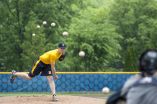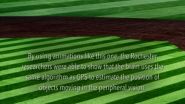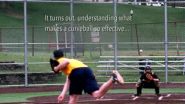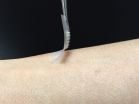(Press-News.org) Our brains track moving objects by applying one of the algorithms your phone's GPS uses, according to researchers at the University of Rochester. This same algorithm also explains why we are fooled by several motion-related optical illusions, including the sudden "break" of baseball's well known "curveball illusion."
The new open-access study published in PNAS shows that our brains apply an algorithm, known as a Kalman filter, when tracking an object's position. This algorithm helps the brain process less than perfect visual signals, such as when objects move to the periphery of our visual field where acuity is low.
However, the same algorithm that helps our brain track motion can be tricked by the pattern motion of an object, such as the seams on a spinning baseball, which causes our brain to "see" the ball suddenly drop from its path when, in reality, it curves steadily.
Though we often rely on Global Positioning System (GPS) to get us to our destination, the accuracy of GPS is limited. When the signal is "noisy" or unreliable, your phone's GPS uses algorithms, including the Kalman filter, to estimate the location of your car based on its past position and speed.
"Like GPS, our visual ability, although quite impressive, has many limitations," said the study's coauthor, Duje Tadin, associate professor of brain and cognitive sciences at the University of Rochester.
We see an object's position with great accuracy when it's in the center of our visual field. We do poorly, however, at perceiving position when it shifts into our visual periphery; then our estimate of its position becomes unreliable. When that happens, our brain gives greater emphasis to our perception of the object's motion.
"And, this is where we start seeing fascinating phenomena like the curveball illusion," said Tadin. "We've found that the same algorithm that is used by GPS to track vehicles also explains why we perceive the curveball illusion."
"A curveball pitch does indeed curve," said the first author Oh-Sang Kwon, assistant professor at Ulsan National Institute of Science and Technology, South Korea. "But when it is viewed in the visual periphery, the spin of the ball--the motion of the seam pattern--can make it appear to be in a different location than it really is.
"Here, the brain 'knows' that position estimates are unreliable in the periphery, so it relies more on other visual cues, which, in this case, is the motion; the spin of the ball," said Kwon, who led the study while serving as a research associate in the Center for Visual Science at the University of Rochester.
The perceived motion and position of the curveball depends on where it is in your visual field. So, when the ball enters your periphery, it appears to make an abrupt shift: The infamous and sudden "break" of the curveball as it nears home plate.
The Kalman filter algorithm, named after its coinventor, mathematician Rudolph Kalman, is used to find optimal and integrated solutions from noisy or unreliable data whether in GPS or our brains.
Most of the time our vision does a really good job, but in some cases, such as a breaking curveball, the optimal solution that our brain comes up with belies the actual behavior--and trajectory--of the ball, and the result is an optical illusion.
Therefore, Tadin explained, you have a better chance of hitting a curveball by realizing that our brains, like GPS, can lead us to "see" changes in speed or direction that don't actually occur when the ball moves from the center of our visual field to the periphery.
"These illusions should not be seen as evidence that our brains are poor at perceiving the world around us, though," explained Tadin. "They are interesting side-effects of neural processes that, in most cases, are extremely efficient at processing 'noisy' visual information."
"This study shows that the solutions that the brain finds for dealing with imperfect information often match optimal solutions that engineers have come up with for similar problems, like your phone's GPS."
INFORMATION:
The senior researcher of the study, David C. Knill, professor of brain and cognitive sciences, and associate director of the Center for Visual Science at the University of Rochester passed away in October 2014.
The National Institute of Health supported the research.
Amid reports that rank today's teens as the most stressed generation in the country, a new study offers hope for helping them effectively manage stress and build long-term resiliency. A pilot study, published in the spring issue of the journal Advances in Mind-Body Medicine, describes how a stress-reduction/resiliency-building curriculum developed by the Benson-Henry Institute (BHI) at Massachusetts General Hospital (MGH) helped a group of Boston-area high school students significantly reduce their anxiety levels, increase productivity and effectively manage stress over ...
PROVIDENCE, R.I. [Brown University] -- Fish are power eaters. In many species, large muscles running along their backs and bellies provide bursts of speed for chasing down prey. Then, at the very instant they close in, they vacuum victims into their suddenly gaping mouths with overwhelming suction. It turns out that these power surges are no anatomical coincidence. A new study shows that largemouth bass get their slurping power from the very same muscles that provide their swimming power.
In the Proceedings of the National Academy of Sciences, Brown University researchers ...
Chemists and biologists at UC San Diego have succeeded in designing and synthesizing an artificial cell membrane capable of sustaining continual growth, just like a living cell.
Their achievement, detailed in a paper published in this week's issue of the Proceedings of the National Academy of Sciences, will allow scientists to more accurately replicate the behavior of living cell membranes, which until now have been modeled only by synthetic cell membranes without the ability to add new phospholipids.
'The membranes we created, though completely synthetic, mimic several ...
WASHINGTON (June 18, 2015) -- Research published in the Proceedings of the National Academy of Sciences found that some individuals exposed to HIV-1, but who remain uninfected, have a certain pattern of virus-specific immune responses that differentiated them from individuals who became infected. The findings build upon prior research by studying these responses in the context of a controlled clinical trial, examining a large number of subjects, and by having access to specimens saved before anyone was infected. In the future, this information could be used to assess HIV-1 ...
CHAPEL HILL, NC - Painful insulin injections could become a thing of the past for the millions of Americans who suffer from diabetes, thanks to a new invention from researchers at the University of North Carolina and NC State, who have created the first "smart insulin patch" that can detect increases in blood sugar levels and secrete doses of insulin into the bloodstream whenever needed.
The patch - a thin square no bigger than a penny - is covered with more than one hundred tiny needles, each about the size of an eyelash. These "microneedles" are packed with microscopic ...
New Vanderbilt-led research shows hospitals are doing a better job of using antibiotics less commonly associated with antibiotic resistance to treat children hospitalized with community-acquired pneumonia (CAP).
The report, 'Antibiotic choice for children hospitalized with pneumonia and adherence to national guidelines,' was released today in the journal Pediatrics.
This study was nested within a larger study, the Centers for Disease Control and Prevention (CDC) Etiology of Pneumonia in the Community (EPIC). The multi-center EPIC study was a prospective, population-based ...
DURHAM, N.C. -- Time management isn't just important for busy people -- it's critical for plants, too. A Duke University study shows how two biological clocks work together to help plants deal with intermittent demands such as fungal infections, while maintaining an already-packed daily schedule of activities like growth.
The researchers also identified a gene that senses disturbances in the 'tick-tock' of one clock, and causes the other clock to tighten its timetable. Their work appears in the June 22 issue of the journal Nature.
From daily sleep/wake cycles and fluctuations ...
For diabetics, a quick prick of the finger can give information about their blood glucose levels, guiding them in whether to have a snack or inject a dose of insulin. Point-of-care glucose meters, or glucometers, are also used in the veterinary world to monitor cats and dogs with diabetes or pets hospitalized for other reasons. In both cases, the device's readout can literally be a matter of life and death.
While glucometers have the advantage of being fast and requiring only a small drop of blood, they are not as accurate as some other methods of measuring blood glucose. ...
Mild elevations in blood pressure considered to be in the upper range of normal during young adulthood can lead to subclinical heart damage by middle age -- a condition that sets the stage for full-blown heart failure, according to findings of a federally funded study led by scientists at Johns Hopkins.
A report on the findings of the multicenter study that followed 2,500 men and women over a period of 25 years is published online June 22 in the Journal of the American College of Cardiology.
Persistently elevated blood pressure, or hypertension, is one that tops 140/90, ...
COLUMBUS, Ohio -- A new study shows that captive black rhinos -- but not their wild counterparts -- are at high risk for two common health problems suffered by millions of humans: inflammation and insulin resistance.
The finding suggests captive black rhinos have metabolic problems. In humans, these same conditions can both result from a rich diet and sedentary lifestyle and contribute to obesity and other diseases.
To be clear, this study does not suggest that zoos cause health problems in black rhinos, said Pam Dennis, clinical assistant professor of veterinary preventive ...




